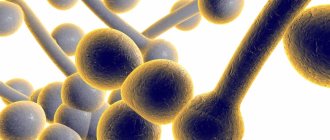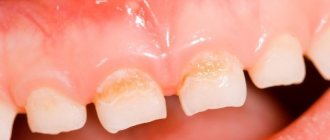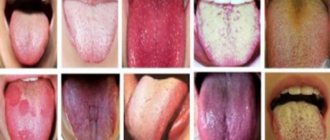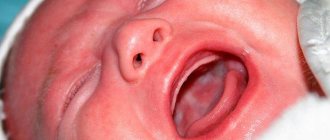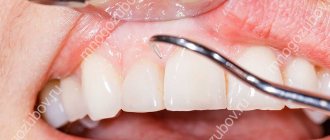If there is a sudden change in the usual appearance of the tongue, for example, when red dots or plaque appears on it, it is imperative to pay attention to this symptom, since this may be an indicator of a serious internal pathology. Many people have probably noticed that with certain diseases the nature of the surface and color of the tongue changes. This is true. This organ not only allows you to distinguish the taste of foods and talk, but also acts as a special indicator.
The tongue is normally pink in color; there may be a small amount of light coating on its root, while the rest of the surface is clean. You can also clearly see the taste buds in the form of mushroom-shaped outgrowths, and there is a clear groove in its center.
What does this mean?
The appearance of red dots on the tongue can be caused by a number of reasons, including those that do not threaten health and life. However, in some cases, such rashes indicate the appearance of a specific disease.
Red dots can have different origins:
- wound, petechiae - slight hemorrhage (with a burn of the tongue, for example);
- telangiectasia, that is, spider veins;
- ulcer;
- erosion;
- epithelial tumor of malignant and benign nature;
- rashes (macula, papule, roseola).
That is why it is of great importance to seek medical help in the case when a person finds red dots on the root of the tongue, as well as on other parts of this organ, in his child or himself.
Non-dangerous causes of appearance
The causes of red dots on the tongue that are not dangerous are:
- Eating foods colored red.
- Eating very hot or spicy food.
- Irritation or injury from wearing dentures.
- Changes in bite after visiting the dentist.
- Tongue burn.
- Allergic reaction to toothpaste and other oral hygiene products, food products.
- Smoking.
If none of the above explanations are found in a person, it is necessary to look for reasons of a more serious nature. The most common ones should be considered.
Burning tongue: treatment methods
After diagnosing and establishing the cause of burning tongue, the doctor prescribes appropriate treatment. The extent of therapeutic intervention mainly depends on the underlying cause of the symptom. For this symptom, the following treatment options are used:
- Analgesic, symptomatic treatment . Anesthetic drugs are used for these purposes.
- Antibacterial therapy . Prescribed when a bacterial infection of the oral cavity is detected.
- Treatment at the dentist . The patient is given a set of therapeutic measures to eliminate caries, pulpitis, gingivitis, periodontitis and other dental diseases.
- Antifungal therapy . It is used for fungal infections of the oral cavity (candidiasis).
- Treatment of diabetes mellitus . Antihyperglycemic drugs are prescribed, as well as a special diet that limits the consumption of simple carbohydrates.
- Antiallergic treatment . Used for allergic reactions. The most effective way in this case is to avoid contact with the allergen. And to relieve an allergic reaction, antihistamines are used.
- Treatment of neurological and mental disorders . Depending on the root cause of the burning sensation in the mouth, the patient is prescribed antiepileptic drugs, antidepressants and other drugs that improve the functioning of the nervous system.
- Psychotherapy. Sometimes psychotherapy helps with this symptom. In particular, this works if the symptom is associated with increased stress levels or a mental health disorder.
- Other types of treatment . An individual treatment regimen is selected for each patient.
Home methods and traditional medicine
To treat this symptom, various traditional medicines are used that have a calming effect on the oral mucosa. Let's look at the most popular means:
- Rinsing with decoctions of medicinal plants . For these purposes, sage, chamomile flowers, aloe, linden flowers and other medicinal plants that have a calming effect are used.
- Rinsing the mouth with a salt solution . Salt has a mild anti-inflammatory and anti-edematous effect.
- Sucking ice cubes . This procedure will not only soothe the “burning” tongue, but also strengthen the throat.
To maintain oral health, it is important to drink enough fluids. This will avoid dry mouth and a number of problems that are associated with this circumstance (in particular, oral infections).
Why do red dots appear?
Red dots on the tongue most often appear with stomatitis (inflammatory processes of the oral mucosa). There are quite a few direct causes of the development of stomatitis, but most often it is a viral infection, for example, of a herpetic nature.
Other factors also include pathogenic bacteria (streptococci, staphylococci), poor nutrition, fungi (for example, candidiasis), thermal or mechanical injuries, side effects of a number of medications, anemia, hormonal imbalance, decreased salivation, and dehydration.
The next common cause of red dots is allergies. It most often differs in food origin. You can suspect it when keeping a food diary. In this case, it is convenient to note the relationship between the appearance of a rash and the use of a specific product.
What are the reasons for red dots and white coating on the tongue? More on this below.
Red spots on a child's tongue
The most common type of spots is red, signaling an inflammatory process4. Reasons for such color changes to occur:
- Allergy . When an allergen enters the mouth, such as food or medicine. Sometimes children put animal fur or plant flowers into their mouths, which can also cause spots.
- Herpes . It is quite rare, but a child can develop a herpes infection in the oral cavity. It indicates a weakened immune system. The baby will be bothered by pain and itching. The temperature may rise.
- Scarlet fever . This childhood infection is not identified by spots on the tongue, but they are a specific sign. Key symptoms: high fever, severe pain and redness of the throat, cough, rash all over the body in the form of small dots.
Mononucleosis
Rashes in the form of red dots on a child’s tongue may indicate the appearance of infectious mononucleosis, that is, an acute viral disease that is provoked by the Epstein-Barr virus.
Petechiae and telangiectasias on the surface of the tongue may indicate diseases of the circulatory system (thrombocytopathy, thrombocytopenia), vascular pathologies (vasculitis), liver diseases (organ failure, cirrhosis, hepatitis).
In some cases, a red dot on the surface of the tongue or under it is a symptom of quite rare diseases, for example, Kaposi's sarcoma, Kawasaki syndrome, tumors and pernicious anemia.
Red dots on the tongue and white coating
In some cases, the appearance of red dots is also accompanied by a yellowish or white coating, which is expressed to a certain extent. When it appears on the root of the tongue, the doctor will most likely discover intestinal or stomach pathologies in the patient. These may include, for example, chronic gastritis. In this case, the therapist will most likely refer the patient to a gastroenterologist.
A tongue covered with a white coating and red dots is often accompanied by bad breath. In this case, the cause could be her illness (for example, stomatitis) or diseases of the intestines and stomach. In some cases, the source of pathological signs is insufficient oral hygiene, so you need to brush your teeth on time and use rinses after meals.
Pimples on tongue
Pimples on the tongue are painful and cause discomfort, but they are easily treated and do not cause complications. A pimple on the tongue can appear for many reasons, most often due to microtrauma of the tongue, stomatitis or herpes. In principle, there cannot be acne on the tongue, since there are no sebaceous glands on it. Those formations that are mistaken for pimples are not actually pimples - they are not filled with purulent exudate. These are small swellings and ulcers on the surface of the tongue. They are white, pink, red, yellow, depending on the complexity of the disease and the cause of formation. Small pimples are very painful, they interfere with eating, talking and even bother the patient at rest.
White pimple on tongue
A white pimple on the tongue most often appears as a result of stomatitis or candidiasis. These two diseases are treated completely differently; you should consult a doctor at the first symptoms in order to correctly diagnose and prescribe treatment. Candidiasis is characterized by white pimples and a coating on the tongue, which in appearance resembles cottage cheese and covers the entire surface of the oral cavity. There are also white pimples on the base, tip and under the tongue.
With stomatitis, small pimples appear on the tongue. There are usually many of them, they can merge with each other. These small white pimples at the tip or root, at the base or underneath are very painful and itchy. The pain intensifies after eating. If such symptoms appear, you should consult a doctor to confirm the diagnosis and prescribe treatment. Treatment consists of antiseptic treatment of the surface of the oral cavity and lifestyle correction, since the main cause of stomatitis is insufficient oral hygiene.
Red pimple on tongue
Red pimples on the tongue are the main sign of glossitis, an inflammatory disease. Outwardly, they look like inflamed red dots that hurt.
Glossitis can appear for many reasons:
- Allergic reaction;
- alcohol abuse;
- eating too hot and spicy food;
- the presence of the herpes virus.
The appearance of yellow pimples on the tongue is usually not an independent disease. Often with stomatitis or candidiasis, the coating on the surface of the tongue takes on a yellowish rather than white tint. Yellow pimples most often also mean either candidiasis or stomatitis.
Pink pimples on the tongue , like yellow ones, are not an independent disease. Usually they are an early stage of glossitis, when the inflammatory process has not yet reached its peak. If pink acne appears, you should immediately consult a doctor for advice.
The main causes of acne:
Mechanical damage
In the process of chewing or biting food, we bite our tongue, resulting in a slight mechanical injury. The risk of surface damage increases when consuming hard foods with sharp edges (crackers, chips, seeds). A small painful swelling or bump forms at the site of the injury, which after some time turns into a white pimple.
You should exclude spicy and hot foods from your diet, carefully monitor oral hygiene, and after a few days the pimple will disappear on its own.
Allergic reaction
An allergic reaction is possible to food, medicine or toothpaste. This causes small white pimples and sores to form that hurt and irritate when eating or drinking liquids. If your doctor suspects an allergy, it is very important to identify the allergen and eliminate it from your diet.
Stomatitis
Stomatitis is a common cause of white or red pimples on the surface of the tongue. The main cause of stomatitis is insufficient oral hygiene, exposure to pathogenic bacteria on the mucous membranes due to dirty hands, unwashed fruits and vegetables. Most often, children suffer from stomatitis, because they tend to put everything in their mouth. At the first suspicion of stomatitis, you should consult a doctor, he will prescribe medications that relieve itching and soreness of the tongue, as well as promote the speedy healing of ulcers and pimples.
Herpes
Herpes can affect all mucous surfaces of the human body, including the oral cavity. In this case, watery pimples may appear on the tongue and inner surface of the cheeks. Without proper treatment, herpes can eventually affect the entire body, including the brain. Therefore, if you have a herpes virus, you should consult a doctor and undergo a course of antiherpetic therapy.
Poor nutrition
If you eat too much spicy and hot food, inflammation of the tongue, or glossitis, may occur. Drinking alcohol in large quantities, as well as smoking, can cause inflammation of the tongue. Therefore, when the first problems appear, you should immediately try to get rid of bad habits.
Pathologies of the patient's internal organs
Pimples on the tongue can be a manifestation of various diseases, including candidiasis or tuberculosis. If a pimple does not go away for a long time, be sure to consult a doctor.
Weakened immunity
If the immune system is weakened as a result of a previous illness or due to a lack of vitamins and microelements, small painful pimples may appear on the surface of the tongue. It is necessary to take immunomodulators, as well as drugs with lactobacilli to normalize intestinal function and correct the activity of the immune system.
You can only get rid of a pimple on your tongue using comprehensive measures. It is necessary to consult a doctor to determine the true cause of its occurrence. The oral cavity should be kept clean, preferably rinsed with a soda solution or a decoction of St. John's wort. It is also necessary to strengthen the immune system and limit the consumption of spicy and too hot foods so as not to irritate the inflamed nodule.
A pimple at the base of the tongue makes it difficult to swallow and even talk; it hurts and causes a lot of trouble. It could be stomatitis, a fungal infection, a sore throat or pharyngitis. Only an experienced doctor can make a correct diagnosis.
A pimple on the tip of the tongue can pop up at the site of a microtrauma as a result of an infection entering the wound.
In any case, it is advisable to consult a doctor and get tested to make an accurate diagnosis.
For any questions, please call: +7 (343) 2000 730; +7 We work daily, without breaks: Mon-Sat 09.00-21.00 Sun 10.00-20.00 We are waiting for you at the address: Ekaterinburg, st. Gottwald 14a, office 6. Dentistry "MK DENT"
Pale tongue tone
Also, red dots on the tip of the tongue without plaque occur with anemia, but the organ itself turns pale, which is very easy to confuse with deposits. When detecting spots on the tongue, a person does not need to immediately worry and panic. First, you should observe your own condition and check whether such spots disappear within a few days. If there are no changes, even after adjusting the diet and the absence of bad habits, it is advisable to still go to see a doctor and take all the tests required to diagnose the disease, as well as undergo an examination.
Causes
The reasons why a brown plaque has formed can be very diverse, ranging from eating foods with coloring properties to the presence of serious chronic diseases. Most often, a brown tongue signals diseases of the digestive system. Moreover, the more intense the color, the more complex and serious the disease.
However, diseases of the gastrointestinal tract are by no means the only reason why there is a brown coating on the tongue.
In the morning after sleep
A brown, white-brown or yellow-brown coating on the tongue in the morning after sleep is a sign of problems in the functioning of the human body. Normally, a white transparent coating may be present in the morning, which can be easily removed with a toothbrush and toothpaste. Sometimes even light brown plaque in the morning is normal if it is easily removed and does not appear again after brushing your teeth. But if in the morning it has an intense color, it is difficult to remove, and some time after cleaning it appears again, you should pay attention to the condition of the bronchopulmonary system (located at the tip of the tongue) or the gastrointestinal tract (closer to the root).
Smoking
A brown coating on the tongue and smoking are, at first glance, incompatible things. However, this is only at first glance. In fact, it is quite common for smokers to have dark spots on their tongue and teeth. The thing is that the resins that make up cigarettes have coloring properties and over time paint not only the tips of the fingers, but also the teeth and even the tongue of the smoker a dark color.
Tea and coffee
Drinking large amounts of hot chocolate, as well as dark chocolate bars, can cause your tongue to turn dark. In this case, a brown coating forms on the tongue and teeth, which is easily removed by brushing.
A brown coating on the tongue from tea may appear if you drink too much strong tea in large quantities. In this case, as with the formation of chocolate deposits, the stains are easily removed after hygiene procedures. Coffee can also cause a brown coating on the tongue, which can be easily removed with a toothbrush and toothpaste. Let us hasten to reassure everyone: such a plaque is not a sign of a disease and does not require special treatment. It may be advised not to overuse excessively strong tea and coffee, limit chocolate consumption, and also more thoroughly clean your teeth, gums and tongue using a toothbrush, toothpaste and special rinses.
Antibiotics and medications
The use of certain medications can also cause a patient to have a brown or dark brown tongue. For example, intense coloring is caused by the use of a drug such as faringosept (used for sore throats and other throat diseases). Plaque occurs after some antibiotics.
Malavit can also cause a brown tongue. There are a number of other drugs that have the same effect; usually the possibility of the formation of a brown coating is indicated in the instructions. In this case, after stopping the drug, side effects also disappear. By the way, a yellow-brown or white-brown coating on the tongue that has formed as a result of taking medications usually does not require discontinuation of the medications themselves or correction of treatment.
Fungal diseases of the oral cavity
Another fairly common reason why a brown coating forms on the tongue is the presence of fungal diseases of the oral cavity in the patient. With mycosis of the mucous membranes of the oral cavity, a white coating that is difficult to remove appears at an early stage. If treatment is not started in a timely manner, it begins to darken. In advanced cases, a focal yellowish-brown plaque forms on the patient, which is usually located in the center of the tongue. In this case, you should immediately consult a doctor and immediately start taking the prescribed medications.
Dysbacteriosis and food poisoning
A brown coating on the tongue, bitterness in the mouth, constipation or diarrhea, especially if accompanied by abdominal pain, usually indicate food poisoning or intestinal dysbiosis. In this case, folk remedies cannot be used; you should immediately consult a doctor to determine the diagnosis and prescribe appropriate treatment. Note that the root cause of the formation should be treated and eliminated, that is, disturbances in the functioning of the digestive system. After recovery, the plaque on the tongue will go away on its own, without any special treatment.
Quite often, the delay in starting treatment is due to the fact that, having noticed a brown coating on his tongue, the patient does not know which doctor to contact. If plaque formation is accompanied by nausea, diarrhea, abdominal pain, or a feeling of bitterness in the mouth, you should consult a gastroenterologist, as these symptoms indicate disturbances in the functioning of the gastrointestinal tract.
If the cause of the formation of a brown coating on the tongue is unknown, you should consult a physician for a full examination, which will allow you to establish the correct diagnosis.
Stomatitis
A brown coating on the tongue in the morning may also indicate the development of stomatitis. In this case, as in many previous ones, at the early stage of the disease a white coating forms, which covers the mucous membranes of the mouth, and when removed causes pain. Usually, already at this stage, the patient consults a doctor and begins taking medications, so the symptoms of the disease stop developing. But if suddenly, for some reason, the patient does not seek help in a timely manner, the plaque gradually turns from white to brown, indicating the progression of the process. In this case, treatment should be started as quickly as possible.
Dehydration
If a patient has a brown tongue, the causes of this condition may lie in dehydration. Typically, long-term severe disorders and disruptions in the gastrointestinal tract are accompanied by dehydration. In this case, it will not be enough to increase the amount of fluid you drink; more competent treatment is necessary, including the use of medications under the supervision of an experienced gastroenterologist.
In this case, the thicker and darker the plaque, the more difficult the patient’s condition. If during treatment the thickness and intensity of the color decreases, then the treatment is successful. If, on the contrary, the thickness of the plaque increases and its color becomes darker, it means that the treatment is ineffective and it needs to be corrected.
B vitamin deficiency and other causes
A brown tongue is a sign of such serious diseases as pellagra, lack of vitamin B, diabetic coma, Addison's disease and some others. In this case, only an experienced doctor can establish the correct diagnosis, based on laboratory tests.
A lack of B vitamins causes not only the appearance of dark brown or black plaque, but also the formation of painful cracks. If you do not start taking the necessary medications in a timely manner, your tongue will later become bright red and as if varnished.
Features of treatment
Barring allergies, trauma and dyes, it is very important to treat permanent stains correctly. You need to go to an appointment with a dentist, who will treat, for example, glossitis, herpes, stomatitis, and identify benign formations in the oral cavity. If the disease is not dental, then he will refer you to a general practitioner, pediatrician, oncologist, cardiologist and gastroenterologist. Specialists may need additional examinations and tests. You cannot self-medicate.
These could be, for example, cancers that require long and serious treatment, as well as earlier diagnosis. Spots caused by pathologies of the gastrointestinal tract and hematopoietic system are treated only when the cause of their appearance is addressed. A hematologist or gastroenterologist can determine it after examination. This disease cannot be dealt with at home; it will only waste time. To get rid of pyogenic granuloma, specialists will prescribe surgery, cryodestruction or electrocoagulation. How else to treat red dots on the tongue?
They try to treat candidiasis on their own with decoctions, rinses, infusions and other folk remedies. Sometimes that's enough. However, most often you need to take antifungal agents internally, as well as immunomodulators and vitamins to strengthen the body as a whole.
Leukoplakia can be cured by dental treatment or elimination of foods with sharp edges from the diet. If the reddened part of the tongue is covered with keratinized grains, this indicates the beginning of a precancerous condition. In this case, you need to contact an oncologist. A “geographical” or “bald” tongue cannot be returned to its former state, since the taste buds and papillae cannot be restored. Allergic reactions in the form of redness occur in children and are difficult to treat if several new foods are introduced into the diet at the same time. Red food is a particular allergen.
White spots on a child's tongue
The easiest way to notice the formation of white areas in the oral cavity of children, which can signal the following problems:
- 1 Candidiasis is an inflammation caused by excessive growth of fungi in the mouth. The spots look like cottage cheese flakes. The problem occurs when the body's defenses are reduced.
- 2 Stomatitis is a common inflammation of the oral cavity in children, accompanied by painful white spots. The cause of infection is bacteria1.
- 3 Leukoplakia is a consequence of frequent minor injuries accompanied by infection.
- 4 Diseases of the digestive system: the tongue is often called an indicator of the functioning of the gastrointestinal tract, so the presence of white areas in combination with symptoms of digestive dysfunction is a reason to worry about the health of the stomach and intestines2.
Prevention
To avoid the reappearance of small red dots on the tongue, you must carefully follow a number of recommendations:
- Eliminating bad habits.
- Scrupulous personal hygiene of the oral cavity, as well as good quality toothpaste and brushes.
- Review your diet and get rid of fast food products that are rich in hot spices.
- Carbonated drinks should not be consumed, especially if they contain a large number of dyes.
- Strengthening the immune system.
- Periodic visits to the doctor.
- It is recommended to harden children, carefully choose a diet, and also exclude the intake of any allergen.
How to remove
If a patient has a brown plaque, treatment should be aimed at eliminating the cause that causes it. First, you need to thoroughly clean your teeth, gums, inner surface of your cheeks and tongue from plaque using a toothbrush and toothpaste. Next, you should observe whether the plaque appears again and, if so, how quickly. And depending on the result obtained, whether or not to consult a doctor. If, after careful hygiene procedures, the plaque disappeared and did not appear again, then it was most likely the result of staining with food or medicine. In this case, there is no reason for alarm or treatment.
But if plaque appears again and again, is difficult to remove, and stays on the tongue for longer than five days, then this is a serious reason to consult a gastroenterologist, since a brown tongue primarily indicates problems with the gastrointestinal tract.
Rinsing the mouth with a decoction of chamomile or calendula flowers will help you deal directly with plaque. You can also chew a small piece of propolis for a few minutes; it has excellent bactericidal properties.
And remember: if the reason that caused the formation of a brown coating on the tongue is eliminated, it will disappear on its own without any measures within a few days. Therefore, you should fight the cause that causes it.


